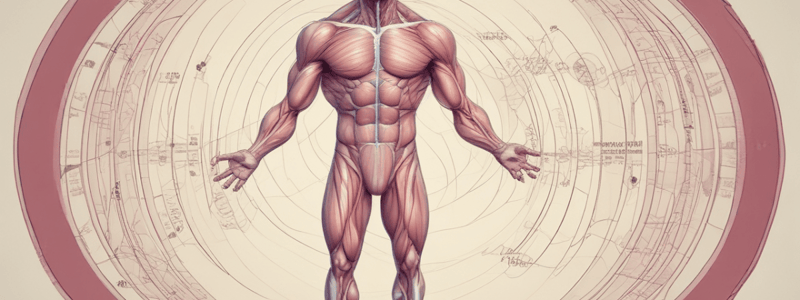Podcast
Questions and Answers
What is the primary usage of ethanol produced through anaerobic fermentation?
What is the primary usage of ethanol produced through anaerobic fermentation?
- Biofuel
- Alcoholic beverages
- Bread rising
- All of the above (correct)
Lactate produced in muscles during physical activity is converted back to glucose in the liver.
Lactate produced in muscles during physical activity is converted back to glucose in the liver.
True (A)
What enzyme is used by the body to metabolize ethanol?
What enzyme is used by the body to metabolize ethanol?
alcohol dehydrogenase
Lactate is converted to _______________ in the liver.
Lactate is converted to _______________ in the liver.
What type of fermentation is used to produce ethanol?
What type of fermentation is used to produce ethanol?
Glycolysis is more energy-efficient than anaerobic fermentation.
Glycolysis is more energy-efficient than anaerobic fermentation.
Match the following sugars with their breakdown products:
Match the following sugars with their breakdown products:
What is the energy efficiency of anaerobic fermentation compared to glycolysis?
What is the energy efficiency of anaerobic fermentation compared to glycolysis?
What happens when NADPH accumulates in the cell?
What happens when NADPH accumulates in the cell?
The non-oxidative phase of the PPP is necessary for generating NADPH.
The non-oxidative phase of the PPP is necessary for generating NADPH.
What is the result of NADPH inhibiting the first enzyme in the PPP pathway?
What is the result of NADPH inhibiting the first enzyme in the PPP pathway?
The ______ barked
The ______ barked
What is the function of the PPP pathway in an active muscle cell?
What is the function of the PPP pathway in an active muscle cell?
Glycolysis is a feeder pathway for the PPP.
Glycolysis is a feeder pathway for the PPP.
Match the following terms with their descriptions:
Match the following terms with their descriptions:
What is the purpose of the oxidative phase of the PPP in an active muscle cell?
What is the purpose of the oxidative phase of the PPP in an active muscle cell?
What is the net balance of glycolysis?
What is the net balance of glycolysis?
In aerobic conditions, NADH is reoxidized to NAD+ by transfer of electrons to the respiratory chain in the mitochondrion.
In aerobic conditions, NADH is reoxidized to NAD+ by transfer of electrons to the respiratory chain in the mitochondrion.
What is the purpose of lactate dehydrogenase in lactate fermentation?
What is the purpose of lactate dehydrogenase in lactate fermentation?
In yeast, pyruvate is fermented to _________________.
In yeast, pyruvate is fermented to _________________.
Match the following compounds with their respective products in fermentation:
Match the following compounds with their respective products in fermentation:
What is the fate of pyruvate in human fermentation?
What is the fate of pyruvate in human fermentation?
Under aerobic conditions, glycolysis cannot continue because NADH cannot be reoxidized to NAD+.
Under aerobic conditions, glycolysis cannot continue because NADH cannot be reoxidized to NAD+.
What is the purpose of regenerating NAD+ from NADH in glycolysis?
What is the purpose of regenerating NAD+ from NADH in glycolysis?
Flashcards are hidden until you start studying
Study Notes
Energy Metabolism
- During short bursts of physical activity, lactate is produced in muscles and transported to the liver, where it's converted back to glucose.
Cori Cycle
- In the liver, an enzyme converts lactate into pyruvate, then into glucose.
- This process is not as efficient as glucose production.
Fermentation
- Fermentation is used to make alcoholic beverages, industrial ethanol, and CO2 for bread to rise.
- In the body, alcohol dehydrogenase is used to metabolize ethanol into acetaldehyde, which is further metabolized.
Anaerobic Fermentation
- Not as energy-efficient as aerobic respiration.
Glycolysis
- Glucose + 2 ATP + 2 NAD+ + 4 ADP + 2 Pi → 2 Pyruvate + 2 ADP + 2 NADH + 2 H+ + 4 ATP + 2 H2O (net balance)
- To continue glycolysis, organisms must reoxidize NADH back to NAD+.
Fate of Pyruvate
- Pyruvate can be fermented into lactate or ethanol, regenerating NAD+ from NADH.
- Human cells ferment pyruvate into lactate, while yeast ferments it into ethanol.
Lactate Fermentation and Cori Cycle
- Under hypoxic or anaerobic conditions, NADH generated by glycolysis cannot be reoxidized by O2.
- Lactate dehydrogenase reduces pyruvate to lactate, using up NADH.
Non-oxidative Phase of PPP Reactions
- PPP reactions are needed in tissues generating NADPH.
- Non-oxidative phase shuffles 5C sugars to 2 6C sugars and glyceraldehyde 3-p.
Metabolic Control of PPP by NADPH
- NADPH regulates the partitioning of glucose 6-phosphate between glycolysis and the PPP.
- When NADPH accumulates, it inhibits glucose-6-phosphate dehydrogenase, diverting glucose 6-phosphate to glycolysis.
Pathway Integration in an Active Muscle Cell
- During exercise, glucose is metabolized through glycolysis, with pyruvate converted to lactate or used for energy production.
- The Cori cycle is an important pathway for lactate produced in muscles, which is then converted back to glucose in the liver.
Studying That Suits You
Use AI to generate personalized quizzes and flashcards to suit your learning preferences.




